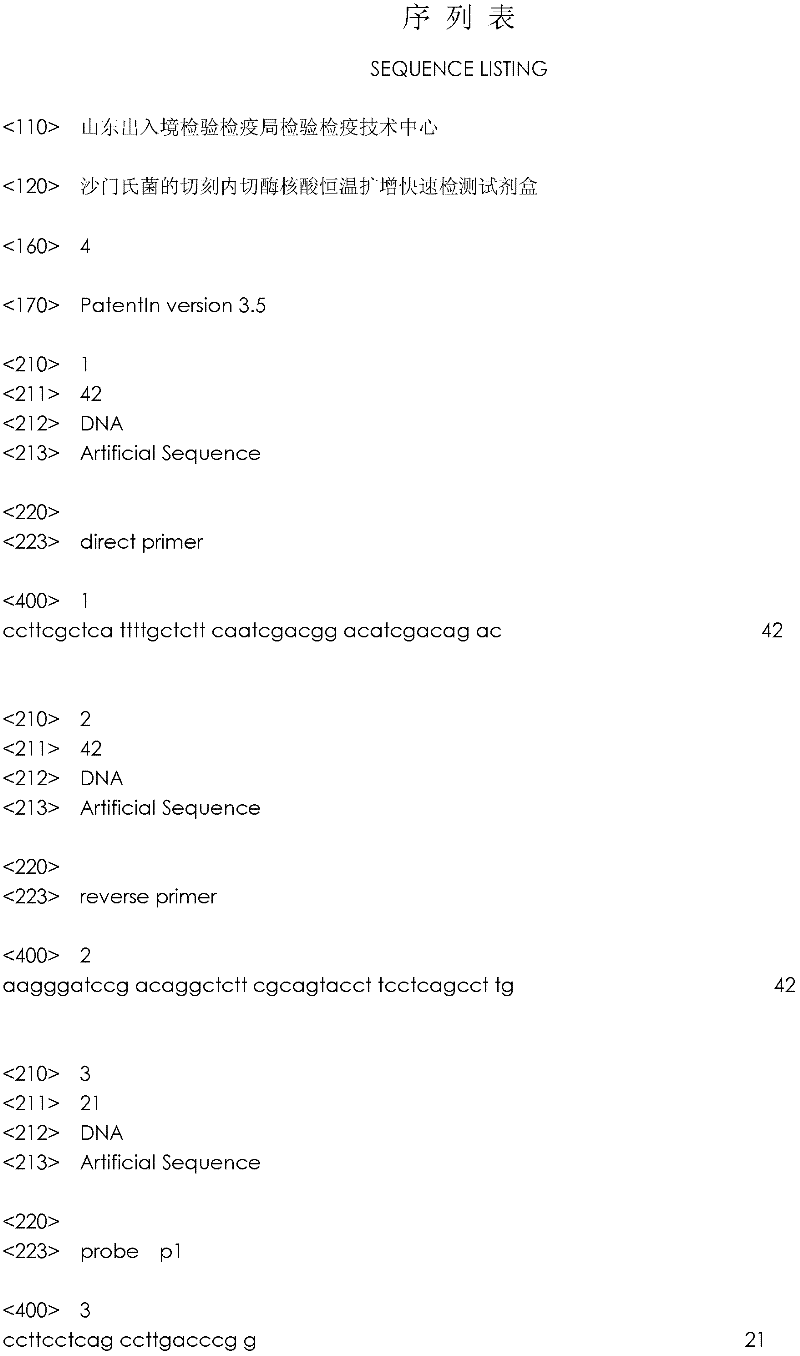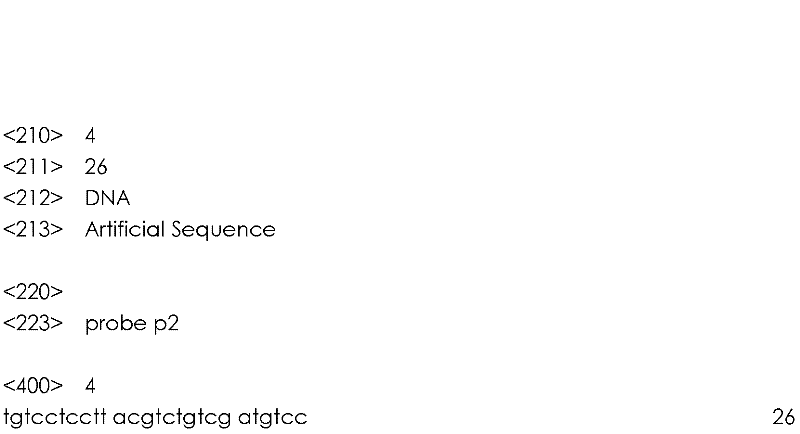Kit capable of quickly detecting amplification of incising incision enzyme nucleic acid of salmonella at constant temperature
An endonuclease nucleic acid, Salmonella technology, applied in the determination/inspection of microorganisms, resistance to vector-borne diseases, DNA/RNA fragments, etc. Effect
- Summary
- Abstract
- Description
- Claims
- Application Information
AI Technical Summary
Problems solved by technology
Method used
Image
Examples
Embodiment 1
[0043] Embodiment 1: to the detection of Salmonella standard bacterial strain
[0044] Prepare Salmonella nicking endonuclease nucleic acid constant temperature amplification kit according to the following formula:
[0045] 1) Template pretreatment reaction solution:
[0046] Each 23μL contains 2.5μL 10×Taq Platinum buffer II, 1.0μL 2.5mmol / L dNTP, 1.0μL 10μmol / L forward primer, 1.0μL 10μmol / L reverse primer, 1.0μL 2.5U / μL Taq Platinum DNA Polymerase and 16.5μL wxya 2 O (sterilized double distilled water).
[0047] The forward primer SEQ ID NO: 1 described therein:
[0048] 5-CCTTCGCTCATTTTT GCTCTTC AATCGACGGACATCGACAGAC-3;
[0049] Reverse primer: SEQ ID NO: 2:
[0050] 5-AAGGGATCCGACAG GCTCTTC GCAGTACCTTCCTCAGCCTTG-3;
[0051] The underlined part in the forward primer and the reverse primer is the nicking endonuclease recognition site;
[0052] 2) NEMA constant temperature amplification reaction solution:
[0053] Each 46 μL contains 5 μL 10×NEBuffer 3, 1.0 μL 2.5 mm...
Embodiment 2
[0076] Example 2: Detection of Escherichia coli ATCC 25922
[0077] Prepare Salmonella nicking endonuclease nucleic acid constant temperature amplification kit according to the following formula:
[0078] 1) Template pretreatment reaction solution:
[0079] Each 23μL contains 2.5μL 10×Taq Plainum buffer II, 1.0μL 2.5mmol / L Dntp, 1.0μL 10μmol / L forward primer, 1.0μL 10μmol / L reverse primer, 1.0μL 2.5U / μL Taq Platinum DNA Polymerase and 16.5 μL ddH 2 O (sterilized double distilled water).
[0080] The forward primer SEQ ID NO: 1 described therein:
[0081] 5-CCTTCGCTCATTTTT GCTCTTC AATCGACGGACATCGACAGAC-3;
[0082] Reverse primer: SEQ ID NO: 2:
[0083] 5-AAGGGATCCGACAG GCTCTTC GCAGTACCTTCCTCAGCCTTG-3;
[0084] The underlined part in the forward primer and the reverse primer is the nicking endonuclease recognition site;
[0085] 2) NEMA constant temperature amplification reaction solution:
[0086] Each 46 μL contains 5 μL 10×NEBuffer 3, 1.0 μL 2.5 mmol / L dNTP, 1.0 μL ...
Embodiment 3
[0109] Example 3: Detection of food samples suspected of being infected with Salmonella
[0110] The food sample was subjected to DNA extraction and amplification detection according to the method described in Example 1, and the product was detected with a universal nucleic acid amplification rapid detection plate. Results The quality control area C showed a red band, and the detection area T also had a red band, indicating that the sample to be tested was infected by Salmonella.
[0111] The primers, probes and kits of the present invention can also detect Salmonella in other samples.
[0112]
[0113]
PUM
 Login to View More
Login to View More Abstract
Description
Claims
Application Information
 Login to View More
Login to View More - R&D
- Intellectual Property
- Life Sciences
- Materials
- Tech Scout
- Unparalleled Data Quality
- Higher Quality Content
- 60% Fewer Hallucinations
Browse by: Latest US Patents, China's latest patents, Technical Efficacy Thesaurus, Application Domain, Technology Topic, Popular Technical Reports.
© 2025 PatSnap. All rights reserved.Legal|Privacy policy|Modern Slavery Act Transparency Statement|Sitemap|About US| Contact US: help@patsnap.com


